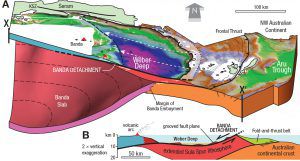FOR the first time geologists have seen and documented the largest exposed fault on earth, the Banda Detachment fault in eastern Indonesia.

Lead researcher from the ANU Dr Jonathan Pownall says the find will help determine dangers of future tsunamis in the area, which is part of the “Ring of Fire”, an area around the Pacific Ocean basin known for earthquakes and volcanic eruptions.
Pownall says: “The abyss has been known for 90 years but until now no one has been able to explain how it got so deep.
“Our research found that a 7km-deep abyss beneath the Banda Sea off eastern Indonesia was formed by extension along what might be Earth’s largest-identified exposed fault plane.”
An analysis of Banda Sea floor maps was conducted by geologists from ANU and the Royal Holloway University of London. Together they found that the rocks flooring the seas are cut by hundreds of straight parallel scars.
The scars suggest that a piece of crust bigger than Belgium or Tasmania has been ripped apart by 120km of extension along a low-angle crack, or detachment fault, to form the present-day ocean-floor depression.

Pownall was on a boat journey in eastern Indonesia in July when he noticed the prominent landforms consistent with surface extensions of the fault line.
“I was stunned to see the hypothesised fault plane, this time not on a computer screen, but poking above the waves,” says Pownall.
“In a region of extreme tsunami risk, knowledge of major faults such as the Banda Detachment, which could make big earthquakes when they slip, is fundamental to being able to properly assess tectonic hazards.”
The research has been published in the journal GEOLOGY.
Who can be trusted?
In a world of spin and confusion, there’s never been a more important time to support independent journalism in Canberra.
If you trust our work online and want to enforce the power of independent voices, I invite you to make a small contribution.
Every dollar of support is invested back into our journalism to help keep citynews.com.au strong and free.
Thank you,
Ian Meikle, editor




Leave a Reply